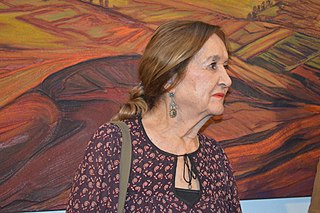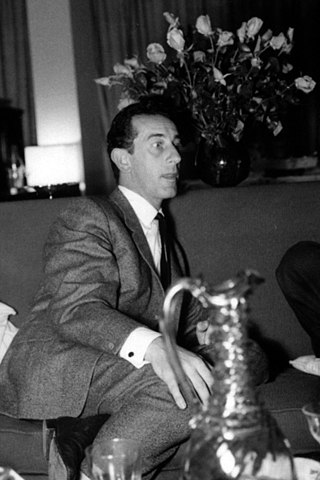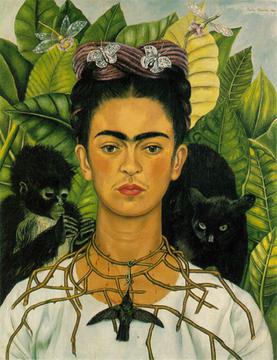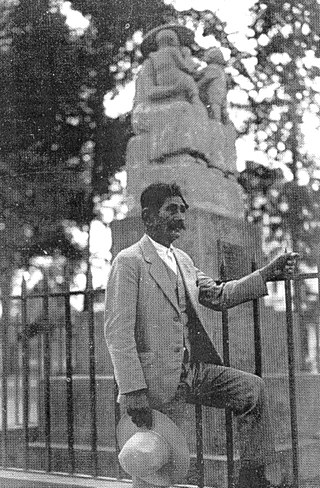Related Research Articles

Diego María de la Concepción Juan Nepomuceno Estanislao de la Rivera y Barrientos Acosta y Rodríguez, known as Diego Rivera, was a prominent Mexican painter. His large frescoes helped establish the mural movement in Mexican and international art.

Magdalena Carmen Frida Kahlo y Calderón was a Mexican painter known for her many portraits, self-portraits, and works inspired by the nature and artifacts of Mexico. Inspired by the country's popular culture, she employed a naïve folk art style to explore questions of identity, postcolonialism, gender, class, and race in Mexican society. Her paintings often had strong autobiographical elements and mixed realism with fantasy. In addition to belonging to the post-revolutionary Mexicayotl movement, which sought to define a Mexican identity, Kahlo has been described as a surrealist or magical realist. She is also known for painting about her experience of chronic pain.

Frida is a 2002 American biographical drama film directed by Julie Taymor which depicts the professional and private life of the surrealist Mexican artist Frida Kahlo.

Arturo García Bustos was a Mexican painter and print maker. He is known as one of “Los Fridos” students who studied under Frida Kahlo at her home in Coyoacán.

Lola Álvarez Bravo was the first Mexican female photographer and a key figure in the post-revolution Mexican renaissance. Known for her high level of skill in composition, her works were seen by her peers as fine art. She was recognized in 1964 with the Premio José Clemente Orozco, by the State of Jalisco, for her contributions to photography and her efforts to preserve the culture of Mexico. Her works are included in the permanent collections of international museums, including the Museum of Modern Art in New York City.

Aurora Reyes Flores was a Mexican artist, known as a painter and writer, and she was the first female muralist in Mexico and first exponent of Mexican muralism. She also went by the name Aurora Reyes.
Julio Castellanos González was a Mexican painter and engraver.

The Frida Kahlo Museum, also known as the Blue House for the structure's cobalt-blue walls, is a historic house museum and art museum dedicated to the life and work of Mexican artist Frida Kahlo. It is located in the Colonia del Carmen neighborhood of Coyoacán in Mexico City. The building was Kahlo's birthplace, the home where she grew up, lived with her husband Diego Rivera for a number of years, and where she later died in a room on the upper floor. In 1957, Diego Rivera donated the home and its contents in order to turn it into a museum in Frida's honor.

Self-Portrait with Monkey is an oil on masonite painting by Mexican artist Frida Kahlo, commissioned in 1938 by A. Conger Goodyear, then president of the Museum of Modern Art in New York City. It is one of the many self-portraits painted by Kahlo for friends and patrons during her career.

Rina Lazo Wasem was a Guatemalan-Mexican painter. She began her career in mural painting with Diego Rivera as his assistant. She worked with him from 1947 until his death in 1957 on projects both in Mexico and Guatemala. Thereafter, she remained an active painter, better known for her mural works than canvases, although the latter have been exhibited in Mexico and other countries. This has made her one of Guatemala's best-known artists. She was a member of the Mexican muralism movement and criticized modern artists as too commercial and not committed to social causes. She believed muralism would revive in Mexico because of its historical value.

Antonio Peláez was a Mexican artist of Spanish origin, who began his career in portraits but in the 1950s shifted to abstract art, concerned with texture, color and the use of space. His work was recognized by a retrospective at the Palacio de Bellas Artes, membership in the Salón de la Plástica Mexicana and a tribute by the Universidad Autónoma Metropolitana after his death.

Louise Frankel Rosenfield Noun was a feminist, social activist, philanthropist, and civil libertarian.

The Two Fridas is an oil painting by Mexican artist Frida Kahlo. The painting was the first large-scale work done by Kahlo and is considered one of her most notable paintings. It is a double self-portrait, depicting two versions of Kahlo seated together. One is wearing a white European-style Victorian dress while the other is wearing a traditional Tehuana dress. The painting is housed at the Museo de Arte Moderno in Mexico City.
The Louise Noun-Mary Louise Smith Iowa Women's Archives is located on the third floor of the Main Library in the University of Iowa Libraries system in Iowa City, Iowa. It was funded when Louise Noun sold a Frida Kahlo painting titled “Self Portrait with Loose Hair” for $1.65 million through Christie’s in New York on May 15, 1991. “It is fitting that the Archives was funded by the sale of a Frida Kahlo painting…[as] Kahlo’s paintings have been rescued from obscurity in recent years…the IWA was meant to rescue the papers of Iowa women from obscurity, neglect, or destruction…"

Self-Portrait with Thorn Necklace and Hummingbird is a 1940 self-portrait by Mexican painter Frida Kahlo which also includes a black cat, a monkey, and two dragonflies. It was painted after Kahlo's divorce from Diego Rivera and the end of her affair with photographer Nickolas Muray.

Mardonio Magaña-Camacho (c.1865–1947) also known as Magañita, was a Mexican educator and sculptor known for his folk art stone direct carvings, he was also known to work with wood and mud. He was a self-taught artist inspired by nature, that was "discovered" by artist Diego Rivera. It's said that Diego Rivera was quoted as saying Magaña was, "the greatest contemporary Mexican sculptor".
Cristina Kahlo y Calderón (1908–1964) was the sister of artist Frida Kahlo. Frida painted a portrait of Cristina, titled Portrait of Cristina, My Sister, and Diego Rivera, Frida's husband, also portrayed Cristina Kahlo in his work. Cristina, with whom Rivera had an affair, was painted by Rivera in the nude.

Two Nudes in a Forest is an oil painting by Mexican painter Frida Kahlo that was completed in 1939. It is also referred to as The Earth, Two Nudes in the Wood, or My Nurse and I. The painting was given to a close woman companion of Kahlo's, who some believe to be actress Dolores del Río. The two women in the painting also appear in Kahlo's 1938 painting What the Water Gave Me, and her spider monkey, which views the couple from the forest, also appears in Kahlo's 1937 Fulang-Chang and I.

Diego and I is a 1949 oil painting by the Mexican artist Frida Kahlo (1907-1954).
References
- 1 2 Rubin, Jr., Louis D. (1995). A Writer's Companion. Baton Rouge: LSU Press. ISBN 9780807119921.
- ↑ Zamora, Martha (1990). Frida Kahlo: Brush of Anguish. San Francisco: Chronicle Books. ISBN 9780811804851.
- 1 2 Lashley, Brooke (2012). "A Displacement of the Self: How Manuel Alvarez Bravo Uses Hair to Represent the Reassertion of an Indigenous Feminine Identity in Postrevolutionary Mexico". Augsburg Honors Review. 5 (8): 7–13. Retrieved 22 April 2023.
- ↑ Rohlfsen Udall, Sharyn (2000). Carr, O'Keeffe, Kahlo: Places of Their Own. New Haven: Yale University Press. ISBN 9780300091861.
- ↑ Karen M. Mason. "Archives for All". Iowa Women's Archive. Retrieved 22 April 2023.
- ↑ Prussell, Deborah (1999). "Louise Noun and The Iowa Women's Archives". Women's History News Network. 1 (61). Retrieved 22 April 2023.
- ↑ Paredez, Deborah (2009). Selenidad: Selena, Latinos, and the Performance of Memory. Durham: Duke University Press. ISBN 9780822390893.